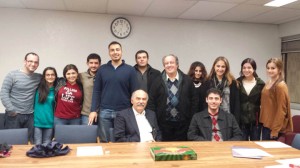Staff Report

The rapidly diminishing Armenian Christian community of Syria, and the still strong Armenian community of Lebanon was the focus of a lecture, “Armenians in the Midst of Civil Wars: Lebanonaand Syria Compared,” by Dr. Ara Sanjian, Director of the Armenian Research Center at the University of Michigan-Dearborn, on Tuesday, December 2, 2014.
The lecture was part of the Fall Armenian Studies Program Lecture Series, funded in part by the Leon S. Peters Foundation.
Dr. Sanjian began his presentation with an overview of the Armenians in Lebanon and Syria. Tens of thousands of Armenian Genocide survivors found refuge in Lebanon after World War I and by 1928 about 33,000 Armenians had settled there. By 1940 the Armenians constituted about 4.5% of the total population and later in 1944 the percentage of the Armenian had risen to over 6%.
By comparison, there were some 100,000 Armenians living within the boundaries of Syria in 1938. After Syria’s independence from France, Armenians constituted about 4% of the total Syrian population of 3,000,000. In both countries, Armenians, as other minorities, were recognized based on their ethno-religious background.
Dr. Sanjian’s lecture gave insight as to the status of the Armenian communities in each country and how the decisions that each community made shaped their status within the respective countries.
During the past several decades both Lebanon and Syria have undergone upheavals. During the Lebanese Civil War of 1975-1990, Armenians adopted the policy of positive neutrality. Most Armenians in Lebanon and Syria today think that this was a wise choice and that it helped to minimize somewhat the heavy toll of civil war for the Armenian community in Lebanon.
The situation for the Armenians in Syria in 2011 was more difficult than for their brethren in Lebanon in 1975. One factor was that the Armenian population of Syria had declined over the same period, while in Lebanon the Armenian population had steadily grown. The Encyclopedia of the Armenian Diaspora put the numbers of Armenians in Syria in 2003 at 65,000-75,000, while the Syrian population at large had grown ten-fold in the period since 1938. Thus the percentage of Armenians as part of the total population had declined to about .03%. The dwindling number of Armenians left them in a more precarious position.
Dr. Sanjian’s analysis and comparison of the Armenians in two of the most important communities in the Middle East provided an important preliminary assessment of the current situation in Lebanon and Syria.
 Hye Sharzhoom Armenian Action
Hye Sharzhoom Armenian Action